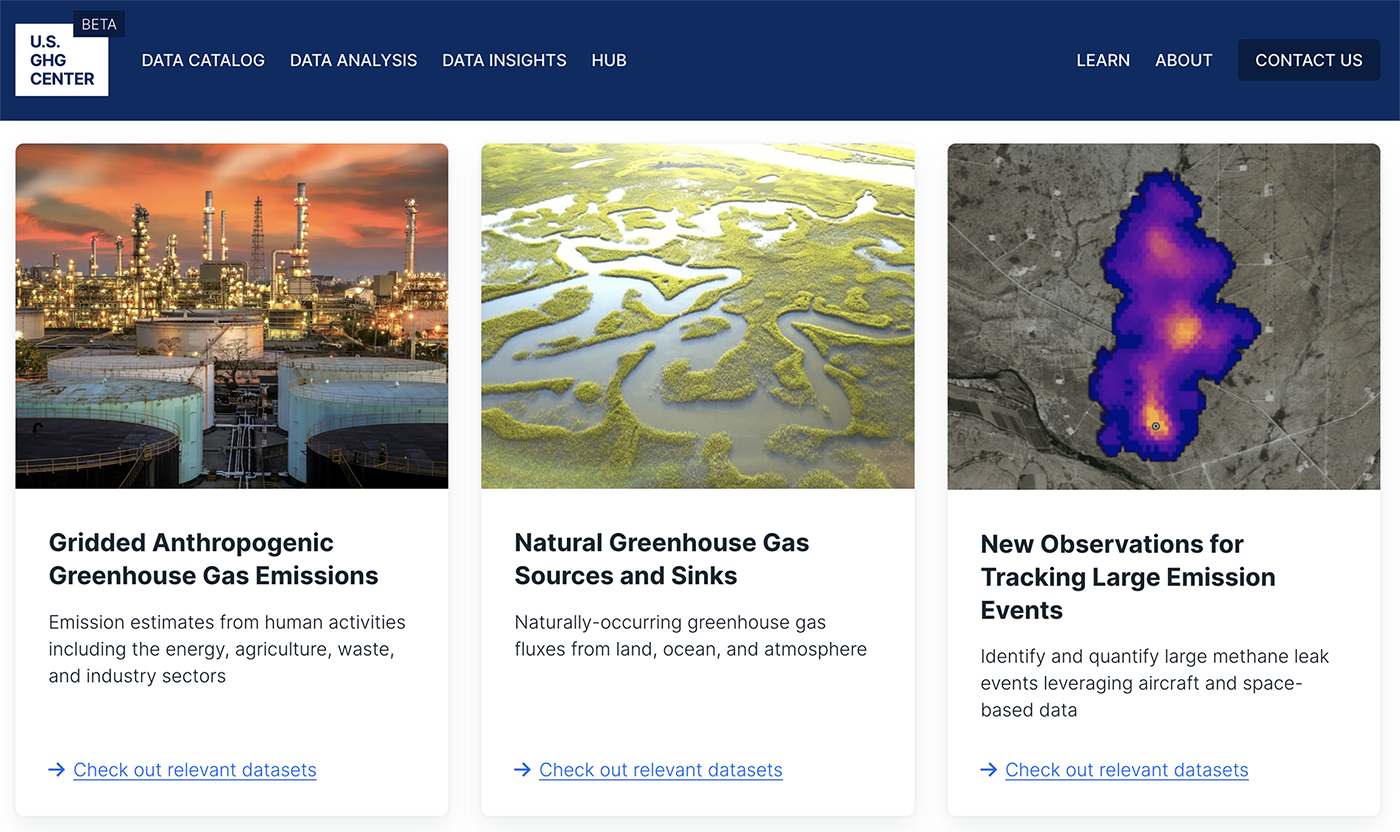On December 4, 2023, NASA and partner agencies announced the launch of the U.S. Greenhouse Gas (GHG) Center portal. The primary aim of the U.S. GHG Center is to expedite the use of Earth science data related to greenhouse gases by offering openly available information in a central location. The GHG Center expands the landscape of open science by providing site visitors with free access to methane, carbon dioxide, and other greenhouse gas datasets coupled with powerful analysis tools and documentation. Through Data Insight narratives authored by GHG Center team scientists, users can also gain perspectives on how data were collected and how they can be interpreted. Anyone from research scientists to the public can benefit from the content in the U.S. GHG Center.
A group within NASA's Interagency, Implementation and Advanced Concepts Team (IMPACT) was—and continues to be—instrumental in building and supporting the U.S. GHG Center portal. The IMPACT GHG Center group is responsible for the design, site development, implementation, maintenance, and daily operations of the U.S. GHG Center portal. This post provides perspectives on the IMPACT effort and the technical aspects of the portal.
Building the Portal
A NASA-led collaboration with scientists from the U.S. Environmental Protection Agency (EPA), National Institute of Standards and Technology (NIST), and National Oceanic and Atmospheric Administration (NOAA) resulted in the launch of the U.S. GHG Center portal in less than six months. By centralizing access to curated, trusted datasets from multiple sources, users have an enhanced capability to explore and compare greenhouse gas emissions and flux data.
The portal was rapidly built by re-using the innovative Visualization, Exploration, and Data Analysis (VEDA) platform. VEDA empowers researchers to explore and analyze Earth science data that are hosted in the cloud. The VEDA system was constructed to unify information and expertise from diverse domains and to create a cohesive platform that fosters collaboration, educates, assists decision makers, and drives novel research. Data visualization capabilities and insight narratives developed by experts are an inherent part of VEDA, which also provides hub access with streamlined optimized datasets in a dedicated cloud computing environment.
Using the VEDA platform as a foundation, the carefully selected datasets in the GHG Center portal, complete with standardized metadata, consolidates information from various sources and eliminates the need for users to navigate to multiple agency and organization websites. The user-friendly data visualization tools empower site visitors to quickly and freely explore the data. Moreover, the scientific community is encouraged to contribute feedback and ideas, ensuring continuous growth and optimization of the GHG Center's functionality.
Furthering Open Science
Both VEDA and the U.S. GHG Center platform are built for open science. IMPACT GHG Center team member Jonas Sølvsteen explains how the GHG Center portal presents datasets according to FAIR data principles, ensuring that the datasets are Findable, Accessible, Interoperable, and Reusable and facilitating transparent and efficient access to reliable information.
"Datasets can be found via the portal and also through the combined catalog, which implements the highly accessible and interoperable Spatio-Temporal Asset Catalog (STAC) specification," Sølvsteen said. "The data are stored in cloud-optimized geospatial data formats, which means that the same, original data can be visualized on the data and information website as well as loaded directly from cloud storage in Amazon Web Services and is optimized for access of relevant portions of the data in space and time."
Converting datasets into cloud-optimized formats and storage was necessary in most instances. Documentation on each dataset's transformation and validation of the resulting cloud data are available to users on the U.S. GHG Center's documentation site. The Center aims to realize a future where original data providers offer all datasets in cloud-native formats, making inclusion of new data into the GHG Center even easier.
For authorized scientific teams and users, the U.S. GHG Center furnishes data science tools through a JupyterHub platform, allowing access to Python, R, or QGIS web browser environments. This access is facilitated in the same cloud and region, ensuring swift and effective data retrieval. Users with a JupyterHub account can explore, analyze, conduct research, and enhance their understanding of scientific data presented in cloud-friendly formats. The provided code and supplementary information facilitate individual exploration and analysis within the cloud environment.
GHG Center Team Lead Deborah Smith notes that the portal was built to meet the needs of many types of users.
"Anyone can take a look at the various datasets and the data insights, which are stories with visualizations aimed at a general audience to introduce various GHG-related topics and data," Smith said. "A plain language introduction is provided for every dataset to aid in understanding what is displayed.”
A Gateway to Greenhouse Gas Information
Unraveling the complexities of greenhouse gas concentrations in Earth's atmosphere requires expertise and often involves navigating numerous information sources and discerning the most relevant datasets for informed decision-making. Additionally, envisaging potential future scenarios is an integral part of understanding and addressing these complexities. Until recently, this task lay squarely in the realm of experts who knew where to search, which data repositories held the most reliable information, and how to extract meaningful insights.
By democratizing access to crucial data and serving as a centralized access point, the U.S. GHG Center serves as a gateway to information dispersed across U.S. government agencies. This initiative not only simplifies the quest for data, but also streamlines the process of accessing comprehensive and credible information on greenhouse gas trends, fostering more informed decisions and strategic planning for our planet's future.
See for yourself, and start exploring the U.S. Greenhouse Gas Center today.
